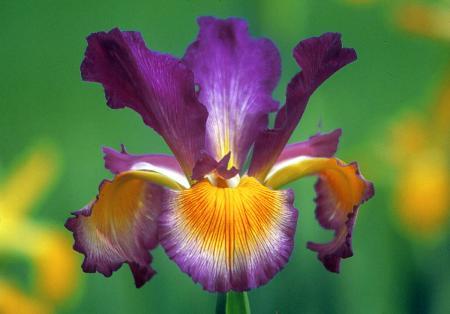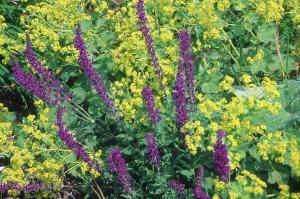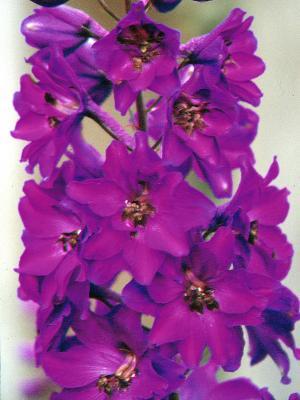By Theresa M. Forte
 |
|
| Purple in all its richness — intensified by a touch of yellow in Iris spuria 'Oroville' |
Envision a length of purple velvet fabric draped over a chair in your mind. Most of us will see a soft, thick, shimmering fabric, suitable for a regal cape. Images of royalty, dignity, power, drama, respect and wealth come to mind. Purple is also a mystical colour. It fosters spirituality, contemplation and self-respect. In meditation, purple is used as the center for creative visualization, it helps to encourage inspiration, and may help to develop a better understanding of one's inner self. Purple is often the favourite colour of those with artistic or philosophical natures and people with a temperamental nature. People who scorn pretension or avoid close relationships often dislike this colour.
In colour therapy, purple is used to soothe ailments of the nervous system, such as skin rashes and tired eyes. Violet can help induce sleep and calm emotional upsets. It helps to develop insight and perception.
Purple must be used with care as too much can appear heavy or depressing. It is a dark colour that shows poorly unless surrounded by lighter colours. Purple looks best when its complementary colour yellow appears nearby. Yellow and purple also affect us in a contrasting manner, according to colour therapists. Yellow relates to intellect while purple suggests intuition. Side by side, equal patches of yellow and purple appear garish, but splashes of yellow near a violet-based colour scheme will add sparkle and help to balance the sombre mood of the grouping.
|
For quiet, contemplative gardens, silver foliage plants are outstanding companions for a predominantly violet, lavender and purple garden. Gertrude Jekyll is renowned for her use of this combination. The gardens at Hestercombe, with their strict geometric layout and soft plantings are a stunning example. The flowers gently tumble over grey stone paths, a soothing mix of Stachys, lavender, santolina and pink China roses. Rosemary, Yucca filamentosa, echinops, nepeta, clematis, aster, Hosta sieboldiana and Buddleia globosa (with silver foliage) are also part of the garden scheme. In her notes to the gardener, Miss Jekyll recommends white, yellow and pale pink snapdragons along with ageratum be used to fill as required. As you can see, the value of including splashes of yellow (for sparkle) and the addition of white and pale pink to brighten and offer contrast were considered essential to the plan by Miss Jekyll.
Colour studies list the variations of purple as separate entities: deep purple, indigo, amethyst, violet, plum, lavender and lilac. How quickly these colours stir the image and fragrance of old fashioned flowers in our minds, the colour and the plant share one name, sweet violet, English lavender and lilac. Along with these images, memories of treasured gardens from our past (and their creators) often enter the mental picture as well. No wonder these colours are considered relaxing and healing. Lavender and lilac are cool colours, leaning more towards blue than red. They tend to create images that are soothing, therapeutic and even a little antiseptic (consider the effects of the herb lavender). These cool colours combine well with other pastel hues in a soft border plan. Not surprising, their most admirable shapes and forms in perennials and shrubs are often soft or cascading themselves, reinforcing the gentle, calm spirit their colours inspire. For example, consider a patch of catmint tumbling over a dry stone wall, or perhaps a lavender-coloured cloud of Russian sage in full bloom in the border, or, the gentle flowers of a lilac bush surrounded by the creamy white snowbells of Viburnum opulus. In a garden, quiet shades of lavender would be suitable for a planting to surround a seating area -- soothing to the mind, encouraging rest. Indigo and violet contain more red than blue. They are warm and rich compared with the cool shades of mauve and lavender. Violet is considered an intuitive and insightful colour, frequently used in gardens designed to encourage contemplation or sanctuary from the hectic world outside their walls. Clematis 'Etoile violette' with its contrasting white eye, and Allium 'Purple Sensation' or 'Globemaster' come to mind when this colour is recommended. Violet sits next to ultraviolet on the colour spectrum. Ultraviolet rays are not visible to the human eye. Many apparently ingenious flowers offer ultraviolet landing patterns to direct pollinating insects into their target areas. These markings are visible to humans only when lit by an ultraviolet light. Shades of purple are easily introduced into the garden and can be included to add interest from early spring to fall. Spring favourites Summer favourites Fall favourites Theresa Forte is a garden columnist, photographer and garden consultant based in Niagara Falls, Ont. Photos by Theresa Forte |

